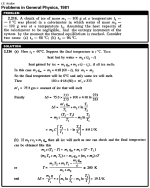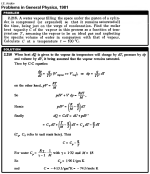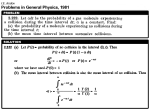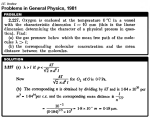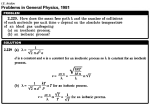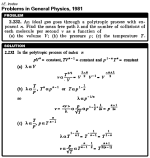| № |
Condition |
free/or 0.5$ |
| 601 | Water of mass m = 1.00 kg is heated from the temperature t1 =10 °C up to t2 =100 °C at which it evaporates completely. Find the entropy increment of the system. |
|
| 602 | The ice with the initial temperature t1 =0 °C was first melted, then heated to the temperature t2 = 100 °C and evaporated. Find the increment of the system's specific entropy. |
|
| 603 | A piece of copper of mass m = 90 g at a temperature t1 = 90 °C was placed in a calorimeter in which ice of mass 50 g was at a temperature —3 °C. Find the entropy increment of the piece of copper by the moment the thermal equilibrium is reached. |
|
| 604 | A chunk of ice of mass m1 = 100 g at a temperature t1 = 0 °C was placed in a calorimeter in which water of mass m2 = 100 g was at a temperature t2. Assuming the heat capacity of the calorimeter to be negligible, find the entropy increment of the system by the moment the thermal equilibrium is reached. Consider two cases: (a) t2 =60 °C; (b) t2 = 94 °C. |
|
| 605 | Molten lead of mass m = 5.0 g at a temperature t2 = 327 °C (the melting temperature of lead) was poured into a calorimeter packed with a large amount of ice at a temperature t1 = 0 °C. Find the entropy increment of the system lead-ice by the moment the thermal equilibrium is reached. The specific latent heat of melting of lead is equal to q = 22.5 J/g and its specific heat capacity is equal to c = 0.125 J/(g·K). |
|
| 606 | A water vapour filling the space under the piston of a cylinder, is compressed (or expanded) so that it remains saturated all the time, being just on the verge of condensation. Find the molar heat capacity C of the vapour in this process as a function of temperature T, assuming the vapour to be an ideal gas and neglecting the specific volume of water in comparison with that of vapour. Calculate C at a temperature t = 100 °C. |
|
| 607 | One mole of water being in equilibrium with a negligible amount of its saturated vapour at a temperature T1 was completely converted into saturated vapour at a temperature T2. Find the entropy increment of the system. The vapour is assumed to be an ideal gas, the specific volume of the liquid is negligible in comparison with that of the vapour. |
|
| 608 | Calculate what fraction of gas molecules (a) traverses without collisions the distances exceeding the mean free path L; (b) has the free path values lying within the interval from L to 2L. |
|
| 609 | A, narrow molecular beam makes its way into a vessel filled with gas under low pressure. Find the mean free path of molecules if the beam intensity decreases n-fold over the distance Al. |
|
| 610 | Let adt be the probability of a gas molecule experiencing a collision during the time interval dt; a is a constant. Find: (a) the probability of a molecule experiencing no collisions during the time interval t; (b) the mean time interval between successive collisions. |
|
| 611 | Find the mean free path and the mean time interval between successive collisions of gaseous nitrogen molecules (a) under standard conditions; (b) at temperature t = 0 °C and pressure p = 1.0 nPa (such a pressure can be reached by means of contemporary vacuum pumps). (b) at temperature t = 0 °C and pressure p = 1.0 nPa (such a pressure can be reached by means of contemporary vacuum pumps). |
|
| 612 | How many times does the mean free path of nitrogen molecules exceed the mean distance between the molecules under standard conditions? |
|
| 613 | Find the mean free path of gas molecules under standard conditions if the Van der Waals constant of this gas is equal to b = 40 ml/mol. |
|
| 614 | An acoustic wave propagates through nitrogen under standard conditions. At what frequency will the wavelength be equal to the mean free path of the gas molecules? |
|
| 615 | Oxygen is enclosed at the temperature 0 °C in a vessel with the characteristic dimension L = 10 mm (this is the linear dimension determining the character of a physical process in question). Find: (a) the gas pressure below which the mean free path of the molecules k > L; (b) the corresponding molecular concentration and the mean distance between the molecules. |
|
| 616 | For the case of nitrogen under standard conditions find: (a) the mean number of collisions experienced by each molecule per second; (b) the total number of collisions occurring between the molecules within 1 cm3 of nitrogen per second. |
|
| 617 | How does the mean free path and the number of collisions of each molecule per unit time v depend on the absolute temperature of an ideal gas undergoing (a) an isochoric process; (b) an isobaric process? |
|
| 618 | As a result of some process the pressure of an ideal gas increases n-fold. How many times have the mean free path A. and the number of collisions 'of each molecule per unit time v changed and how, if the process is (a) isochoric; (b) isothermal? |
|
| 619 | An ideal gas consisting of rigid diatomic molecules goes through an adiabatic process. How do the mean free path A, and the number of collisions of each molecule per second v depend in this process on (a) the volume V; (b) the pressure p; (c) the temperature T? |
|
| 620 | An ideal gas goes through a polytropic process with exponent n. Find the mean free path L and the number of collisions of each molecule per second v as a function of (a) the volume V; (b) the pressure p; (c) the temperature T. |
|



